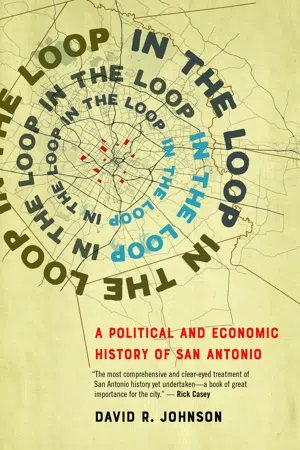CHAPTER ONE
1. Deed of Sale, Mar. 9, 1844, by James Dunn, Coroner, to Samuel A. Maverick, Maverick Family Papers, Business and Financial Papers: Samuel Augustus Maverick, 1842–1907, Dolph Briscoe Center for American History, University of Texas at Austin, Box 2F9.
2. On the theoretical elements required for successful city-building, see Mario Polèse, The Wealth and Poverty of Regions: Why Cities Matter (University of Chicago Press, 2009), 29–66.
3. Carl Abbott, How Cities Won the West: Four Centuries of Urban Change in Western North America (Albuquerque: University of New Mexico Press, 2008), 20–25 discusses the imperial context for town planning.
4. Gerald E. Poyo, “Immigrants and Integration to Late Eighteenth-Century Bexar,” in Tejano Origins in Eighteenth-Century San Antonio, ed. Gerald E. Poyo and Gilberto M. Hinojosa (Austin: University of Texas Press, 1991), 96; and Jesus F. de la Teja, “Forgotten Founders: The Military Settlers of Eighteenth-Century San Antonio de Bexar,” in Tejano Origins, 28–29. Entries for Los Adaes and La Bahía are in the Handbook of Texas Online, https://tshaonline.org.
5. For a discussion of the Spanish approach to Texas colonization, see: T. R. Fehrenbach, Lone Star: A History of Texas and the Texans (Toronto: Macmillan, 1969), 46, 50; and Jesus F. de la Teja, San Antonio de Bexar: A Community on New Spain’s Northern Frontier (Albuquerque: University of New Mexico Press, 1995), 5–7.
6. De la Teja, San Antonio de Bexar, 7.
7. De la Teja, 9–10.
8. Gerald E. Poyo, “The Canary Islands Immigrants of San Antonio: From Ethnic Exclusivity to Community in Eighteenth-Century Bexar,” in Tejano Origins, 42–46.
9. Fehrenbach, Lone Star, 76–77.
10. De la Teja, San Antonio de Bexar, 19–21.
11. Poyo, “Immigrants and Integration,” 96–100.
12. Poyo, “Canary Islands Immigrants,” 52–53; and Elizabeth A. H. John, “Independent Indians and the San Antonio Community,” in Tejano Origins, 125–27.
13. Jesus F. de la Teja and John Wheat, “Bexar: Profile of a Tejano Community, 1820–1832,” in Tejano Origins, 5–7, 17–24; and Raul A. Ramos, Beyond the Alamo: Forging Mexican Ethnicity in San Antonio, 1821–1861 (Chapel Hill: University of North Carolina Press, 2008), 27–41.
14. De la Teja and Wheat, “Bexar: Profile,” 19.
15. De la Teja and Wheat, 19; Ramos, Beyond the Alamo, 86–93; and Fehrenbach, Lone Star, 137–38.
16. Fehrenbach, Lone Star, 143.
17. De la Teja and Wheat, “Bexar: Profile,” 20.
18. Ramos, Beyond the Alamo, 39–47; and Andres Resendez, Changing National Identities at the Frontier: Texas and New Mexico, 1800–1850 (New York: Cambridge University Press, 2005), 96, 98–100, 112.
19. Almonte’s report quoted in John J. Linn, Reminiscences of Fifty Years in Texas (Austin: Steck, 1935; facsimile reproduction of 1883 edition), 98.
20. De la Teja and Wheat, “Bexar: Profile,” 7.
21. De la Teja and Wheat, 5.
22. Poyo and Hinojosa, eds., Tejano Origins; Ramos, Beyond the Alamo; and Timothy M. Matovina, Tejano Religion and Ethnicity: San Antonio, 1821–1860 (Austin: University of Texas Press, 1995) argue the case for this sense of distinctiveness.
23. Students of urban development will recognize here a version of the long debate over the importance, or insignificance, of local efforts to shape urban growth in the context of various forces that either inhibit or promote that growth. See, inter alia, Paul E. Peterson, City Limits (University of Chicago Press, 1981); John R. Logan and Harvey L. Molotch, Urban Fortunes: The Political Economy of Place (Berkeley: University of California Press, 1987); and Clarence N. Stone, Regime Politics: Governing Atlanta (Lawrence: University Press of Kansas, 1989). My point here is that San Antonio’s leaders had little choice but to organize a local initiative to promote growth because the town ultimately found itself in an independent republic that had little capacity to defend itself, let alone any ability to help urban development beyond facilitating land sales to encourage immigration from the United States.
24. T. R. Fehrenbach et al., The San Antonio Story (Tulsa, Okla.: Continental Heritage, 1978), 21–23.
25. Fehrenbach et al., San Antonio Story, 27, 29; Poyo and Hinojosa, eds., Tejano Origins, 48–49; and Cecilia Steinfeldt, San Antonio Was: Seen through a Magic Lantern (San Antonio Museum Association, 1978), 32.
26. De la Teja and Wheat, “Bexar: Profile,” 3; and Carland Elaine Crook, “San Antonio, Texas, 1846–1861” (master’s thesis, Rice University, 1964), 151.
27. De la Teja and Wheat, “Bexar: Profile,” 18.
28. Robert G. Albion, The Rise of New York Port, 1815–1860 (Hamden, Conn.: Archon, 1961; reprint), 373–88; and John W. Reps, The Making of Urban America: A History of City Planning in the United States (Princeton University Press, 1965), 216–17.
29. Reps, Making of Urban America, 302–4, 314, 378.
30. Daniel J. Boorstin, The Americans: The National Experience (New York: Random House, 1965), 115–23, 161–68; Carl Abbott, Boosters and Businessmen: Popular Economic Thought and Urban Growth in the Antebellum Middle West (Westport, Conn.: Greenwood Press, 1981); and William Cronon, Nature’s Metropolis: Chicago and the Great West (New York: W. W. Norton, 1991), 53–54.
31. Wells A. Hutchins, “The Community Acequia: Its Origin and Development,” Southwestern Historical Quarterly 31 (Jan. 1928): 261–63, 265, 271, 279–80.
32. Fehrenbach et al., San Antonio Story, 31.
33. An Act Incorporating the City of San Antonio and Other Towns Therein Named, in The Laws of Texas, 1822–1897, comp. H. P. N. Gammel (Austin: Gammel, 1898), I:1379–81; Matovina, Tejano Religion, 34; and Cecil Scanlan, “John W. Smith: G.T.T.” (unpublished paper, 1984), 27, in author’s possession.
34. John B. Pitts III, “Speculation in Head Right Grants in San Antonio from 1837 to 1842” (master’s thesis, Trinity University, 1966), 2, 5–6, 10.
35. Pitts, 52–69.
36. Scanlan, “John W. Smith,” passim.
37. L. W. Kemp, “Joseph Baker,” Handbook of Texas Online, tshaonline.org.
38. Pitts, “Speculation in Head Rights Grants,” 13–14.
39. “San Antonio P...
